VERDUN - Flabas German Reprisals Camp - Ville-devant-Chaumont German War Cemetery
duda-wsm • 21 March 2019
Years of visit: 2006, 009

From the Bois des Caures we go to the north, "behind the German lines", to visit the location of the Flabas German Reprisals POW Camp, and eastward, to the Ville devant Chaumont - German War Cemetery.
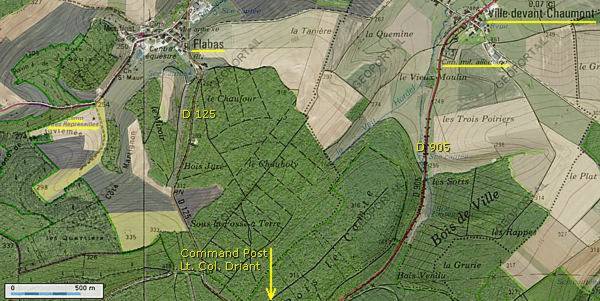
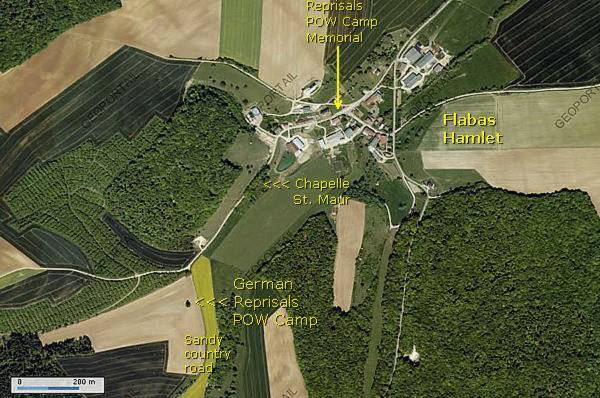
In the centre of the during the war destroyed hamlet of Flabas stands a rather small, but an impressive sculpture, a memorial, dedicated to the French Prisoners Of War of Flabas.
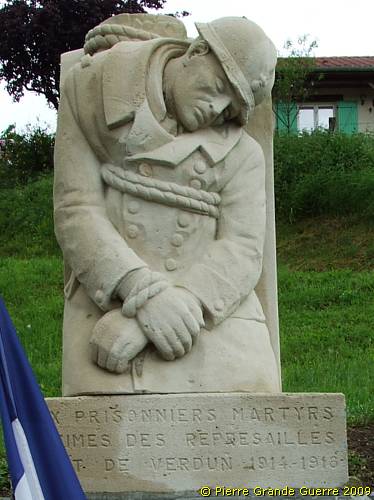
From this memorial we follow the road southeastward.
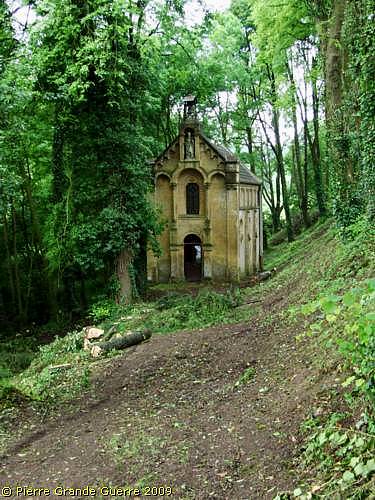
We pass the Chapelle de St. Maur (Chapel of St. Maur).
The Chapelle Saint Maur is named after a Bishop of Verdun, who lived around 356.
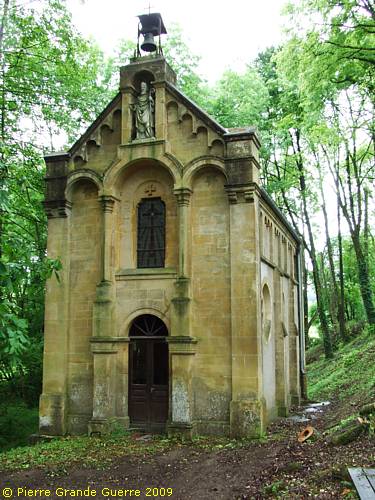
Being a centre of pilgrimage the chapel has been built in 1867.
It was totally destroyed during the Great War, and rebuilt on the original foundation in 1930.
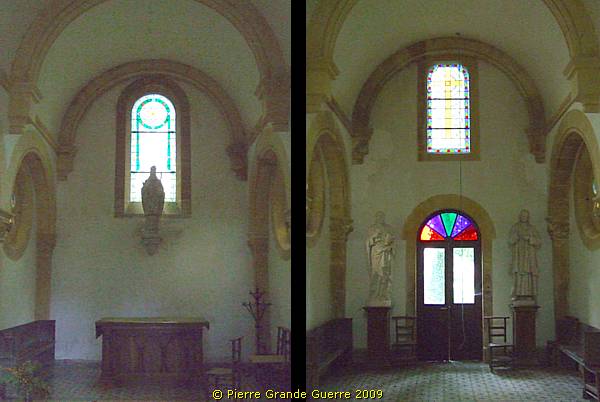
This small group of trees along a sandy road, marks the former location of the German detention camp for French
Prisoners of War, west and outside the hamlet of Flabas.
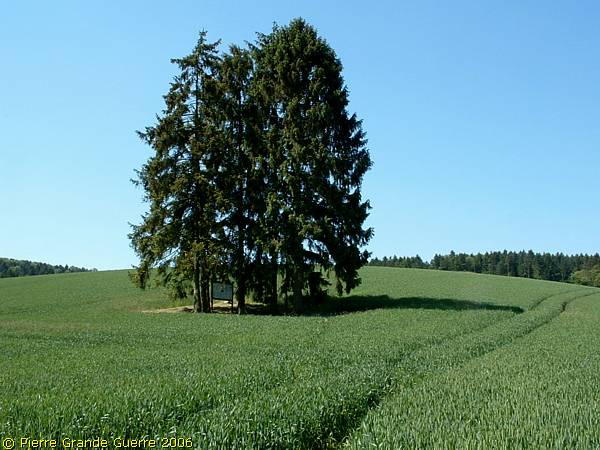
Only a modest remembrance stone under the trees shows an inscription.

Under the trees stands an information panel with a comprehensive text in the French and German language which commemorates the atrocities, the Germans executed here on their French Prisoners of War.

While visiting this spot, the text on this information board made quiet an impression on us.
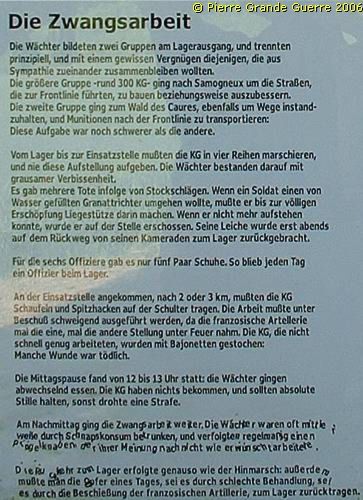
I will give you a summary of the content in English. The horrifying story of Flabas is an important example of
how needlessly cruel a war, in all it's appearances, can be.
Summary of the events at
the Flabas Reprisals Camp
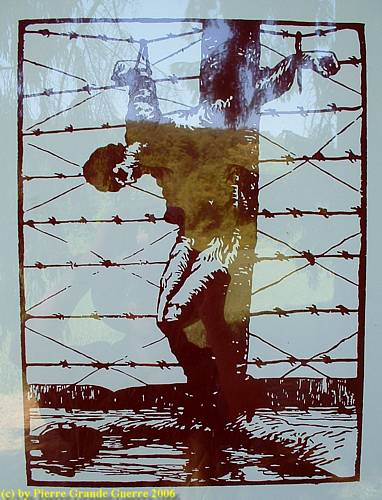
On 21 December 1916, the German Army authorities demanded from the French, that they withdrawed their Prisoner of War Camps to a distance of 30 km behind the frontline near Verdun. If the French did not meet this ultimatum on 15 January 1917, the Germans threatened to build their POW Camps within reach of French artillery and infantry fire.
The camp in Flabas was only 50 m long and 30 m wide, only fenced with barbed wire. The only barrack in the camp was not sufficient to house the 500 prisoners.
300 Prisoners had to stay out in the open air, even in wintertime. There was another barrack for use as lazarets and mortuary, and a cabin, functioning as kitchen.
One German officer, a "Feldwebel", two "Unteroffiziere", and 40 Stormtroopers were guarding the prisoners. The Stormtroopers executed a brutal regime over the prisoners. The "Feldwebel" had many cruel deaths on his conscience. The day started with Stormtroopers forcing their clubs on the prisoners. On only 4 days in the week the prisoners received one meal a day, existing of a small piece of bread, "Abendbrot". From dawn until dusk the prisoners had to do forced labour: building roads in the line of fire in the Bois des Caures and in the direction of the lines of Samogneux. After a day of forced labour, parties of 10 prisoners were forced to get water 600 m away in the line of fire.
One prisoner tried to escape. The Stormtroopers punished this prisoner by tiying him up with barbed wire on the fence with his feet hanging lose from the ground. Next the Stormtroopers clubbed him to death.
After several months the French authorities did meet the demands of the German governement. Immediately after this event the fate of the prisoners changed. They were withdrawn to camps near Montmédy and Longuyon. They were allowed again to take care of their personal hygiene and to receive post from their families. Only 300 prisoners out of 500 would survive this reprisals camp!
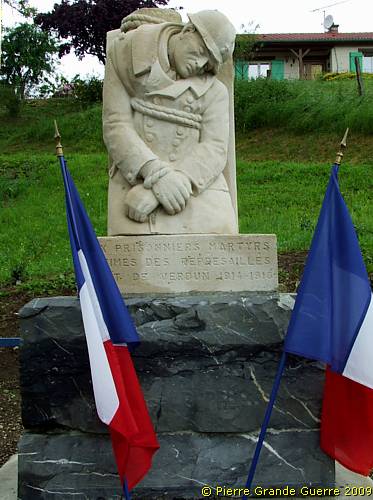
In silence we left this beautiful, but "guilty", landscape outside the hamlet of Flabas ...,

... to continue some 2 km. to the east, to the Ville-devant-Chaumont - Deutscher Kriegsgräberstätte
.
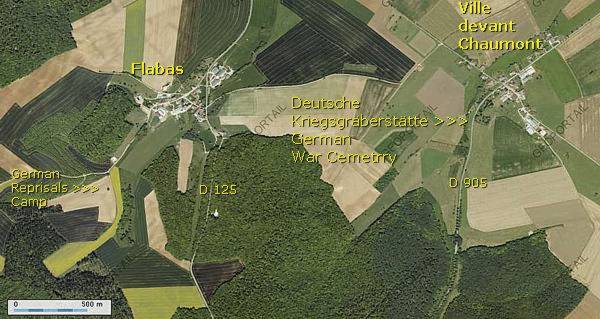
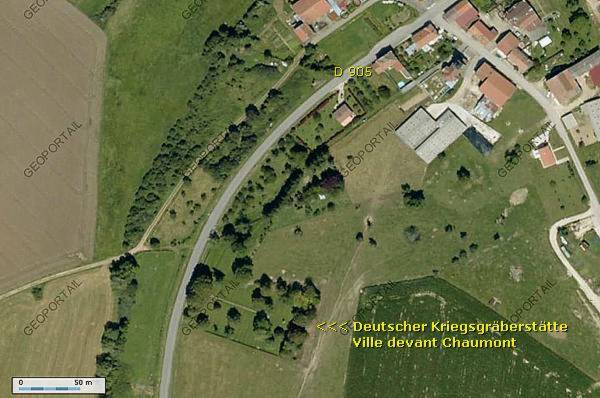
The Ville-devant-Chaumont - German War Cemetery ...

... is located near and "behind the German lines", north-east of the Bois des Caures.
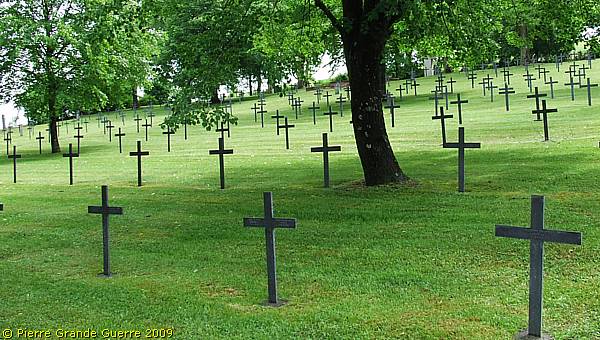

We walk over the cemetery south-eastward.
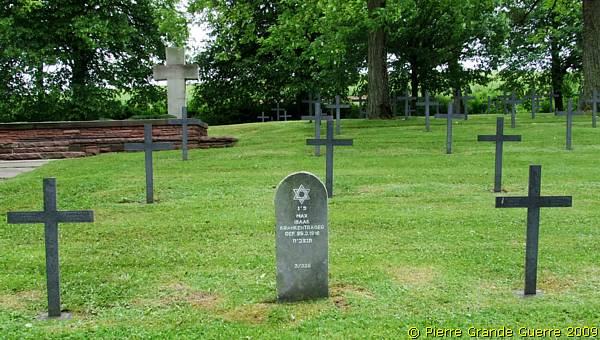
On the top of the hill, is a mass grave.
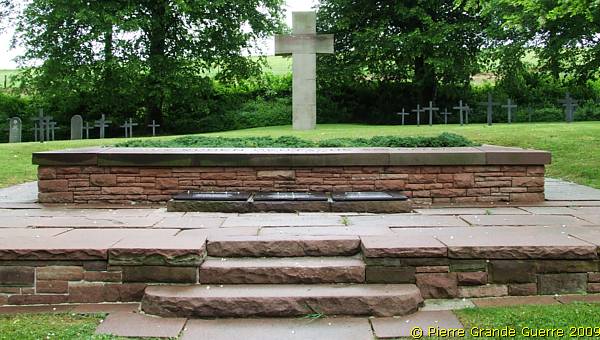
At the foot lay three bronze plagues next to each other.
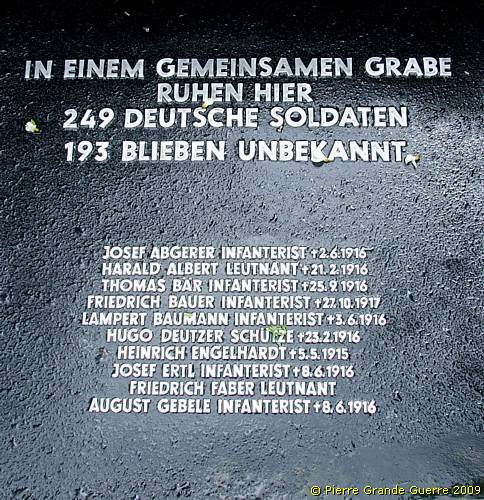
The list of names of 56 known soldiers, killed in 1916 and 1917.
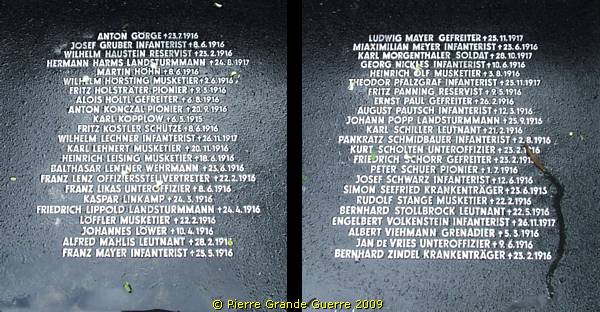
View from the mass grave southward.
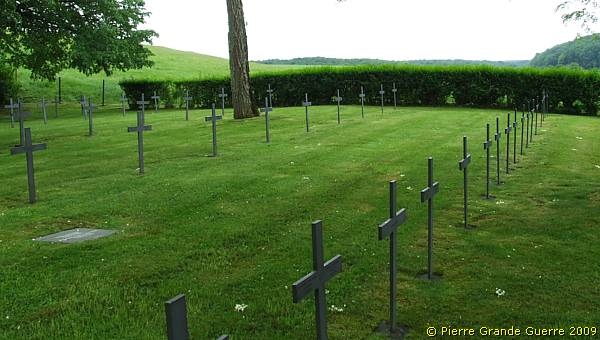
Besides steel crosses there also gravestones, shared by two or sometimes more soldiers.
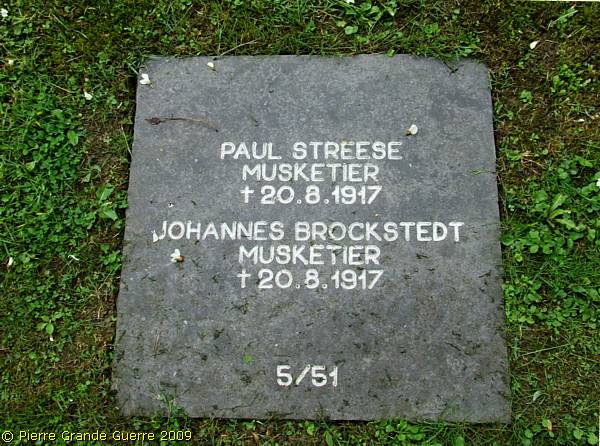
View south-eastward at the Bois le Comte, near and north of the Bois des Caures.

With a last view from the hill to the road, we leave the cemetery.

We go on to the Bois d'Hingry, near Loison, to the ruins of the German concrete factory of Hauptmann Marguerre.
Continue
to the next chapter: " The German Camp Marguerre
" .

Inleiding: Franz Von Papen & Werner Horn; schaker en pion Onlangs stuitte ik in een oud boek (1) van 1919 op een opmerkelijk verhaal over een Duitse Luitenant, die in begin februari 1915 een half geslaagde bomaanslag pleegt op een spoorbrug over een grensrivier tussen de Verenigde Staten en Canada. Ook al staat de bekentenis van de dader, Werner Horn, deels in het boek te lezen, de naam van zijn opdrachtgever zal Horn blijven verzwijgen. Na wat verder zoeken vond ik ook de naam van Horn’s opdrachtgever, Franz von Papen, een van de aangeklaagden van het latere Neurenberg Proces in 1946. In een Grote Oorlog als de Eerste Wereldoorlog is Horn’s aanslag op de brug uiteraard slechts een bescheiden wapenfeit. Toch vermoed ik dat dit relatief onbekende verhaal, dat de geschiedenis is ingegaan als de “ Vanceboro International Bridge Bombing ”, nog interessante kanten kent. Het is onder andere een spionageverhaal over hoe in een groter plan een sluwe schaker zijn naïeve pion offert. Beknopte situatieschets Canada en de Verenigde Staten in 1915

This trip we start at the Léomont near Vitrimont and we will with some exceptions concentrate on the Battle of Lorraine of August-September 1914 in the area, called, the “Trouée de Charmes”, the Gap of Charmes. After the Léomont battlefield we continue our explorations to Friscati hill and its Nécropole Nationale. Next we pay a visit to the battlefield of la Tombe to go on to the Château de Lunéville. There we cross the Vezouze to move on southward to the Bayon Nécropole Nationale. At Bayon we cross the Moselle to pass Charmes for the panorama over the battlefield from the Haut du Mont. North-west of Charmes we will visit the British Military Cemetery containing 1918 war victims. From Charmes we go northward to the battlefield of the First French Victory of the Great War, the Battle of Rozelieures of 25 August 1914. North of Rozelieures we will visit the village of Gerbéviller. From there we make a jump northward to visit the ruins of Fort de Manonviller to finish with an interesting French Dressing Station bunker, west of Domjevin.

Though we depart from Badonviller in the Northern Vosges , we make a jump northward to the east of Lunéville and Manonviller . We start at Avricourt on the border of Alsace and Lorraine. From the Avricourt Deutscher Soldatenfriedhof we explore the southern Lorraine battlefields ; the mine craters of Leintrey , the Franco- German war cemetery and Côte 303 at Reillon , and some German bunkers near Gondrexon , Montreux , and Parux .

North-east of Nancy, east of Pont-à-Mousson, and south-east of Metz we visit the battlefields of the Battle of Morhange of 14 until 20 August 1914. We follow mainly topographically the route of the French advance eastward over the Franco-German border of 1871-1918. During this visit, we try to focus on the day that the momentum of the battle switched from the French side to the advantage of the Bavarian side: the day of 20 August 1914, when the Bavarians rapidly re-conquered the territory around Morhange , being also the day of the start of their rather successful “Schlacht in Lothringen”. We will visit beautiful landscapes of the "Parc Naturel Régional de Lorraine", memorials, ossuaries, and cemeteries. Sometimes we will divert to other periods of the Great War, honouring Russian and Romanian soldiers, who died in this sector. We start our route at the border village of Manhoué, and via Frémery, Oron, Chicourt, Morhange, Riche, Conthil, Lidrezing, Dieuze, Vergaville, Bidestroff, Cutting, Bisping we will finish in Nomeny and Mailly-sur-Seille, where the Germans halted their advance on 20 August 1914, and where they constructed from 1915 some interesting bunkers.

South of Manhoué we start this trip at Lanfroicourt along the French side of the Franco-German 1871-1918 border, marked by the meandering Seille river. We visit some French bunkers in Lanfroicourt, near Array-et-Han and in Moivrons. From there we go northward to the outskirts of Nomeny and the hamlet of Brionne to visit the ( second ) memorial, commemorating the events in Nomeny of 20 August 1914. We continue westward to finish at the Monument du Grand Couronné at the Côte de Géneviève, a former French artillery base, which offers several panoramic views over the battlefield.

North of Pont-à-Mousson and south of Metz, we explore the relics of German bunkers and fortifications along the Franco-German 1871-1918 border. We start at Bouxières-sous-Froidmont to visit the nearby height of the Froidmont on the front line. This time we will show only a part of the Froidmont, focusing on its military significance. From the Froidmont we continue via Longeville-lès-Cheminot and Sillegny to the “Forêt Domaniale de Sillegny” to explore some artillery ammunition bunkers. Next we continue to Marieulles for its three interesting bunkers and to Vezon for its line of ammunition depot bunkers. From Vezon we continue to the “Deutscher Kriegsgräberstätte Fey – Buch”. From Fey we go eastward, passing 6 bunkers near Coin-lès-Cuvry to finish our trip at the top construction of the “Feste Wagner” or “Fort Verny”, north of Verny.

We concentrate on the German side of the front around "Markirch", Sainte Marie-aux-Mines, the so-called "Leber" front sector . We first pay a visit to the Sainte-Marie-aux-Mines Deutscher Soldatenfriedhof, and next to the southern side of the Col de Ste. Marie for the many interesting bunkers of the German positions at the Bernhardstein, at the north-eastern slopes of the Tête du Violu. On the next photo page about the Haut de Faîte we will continue with a visit to the northern side of the pass and the "Leber" sector.



